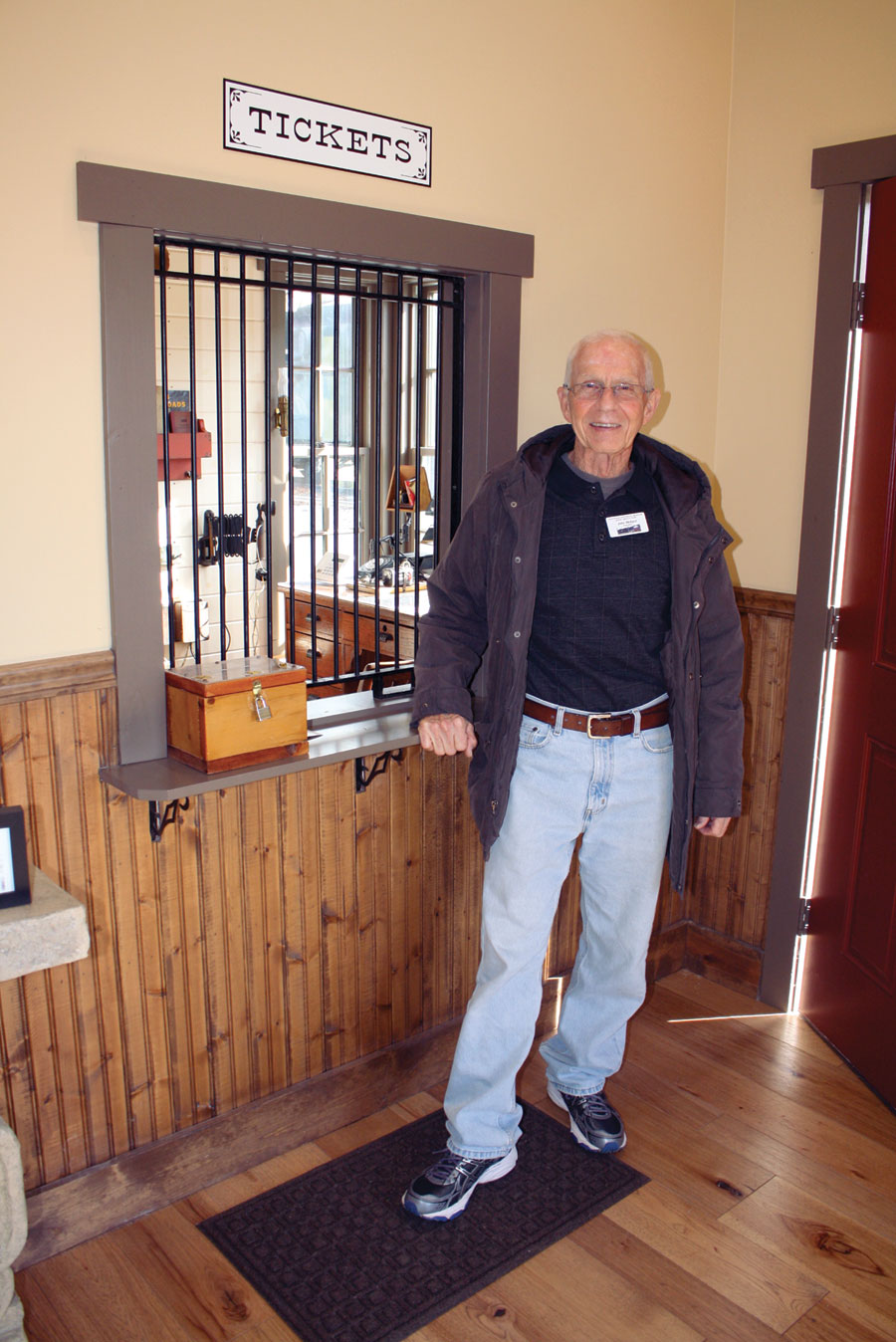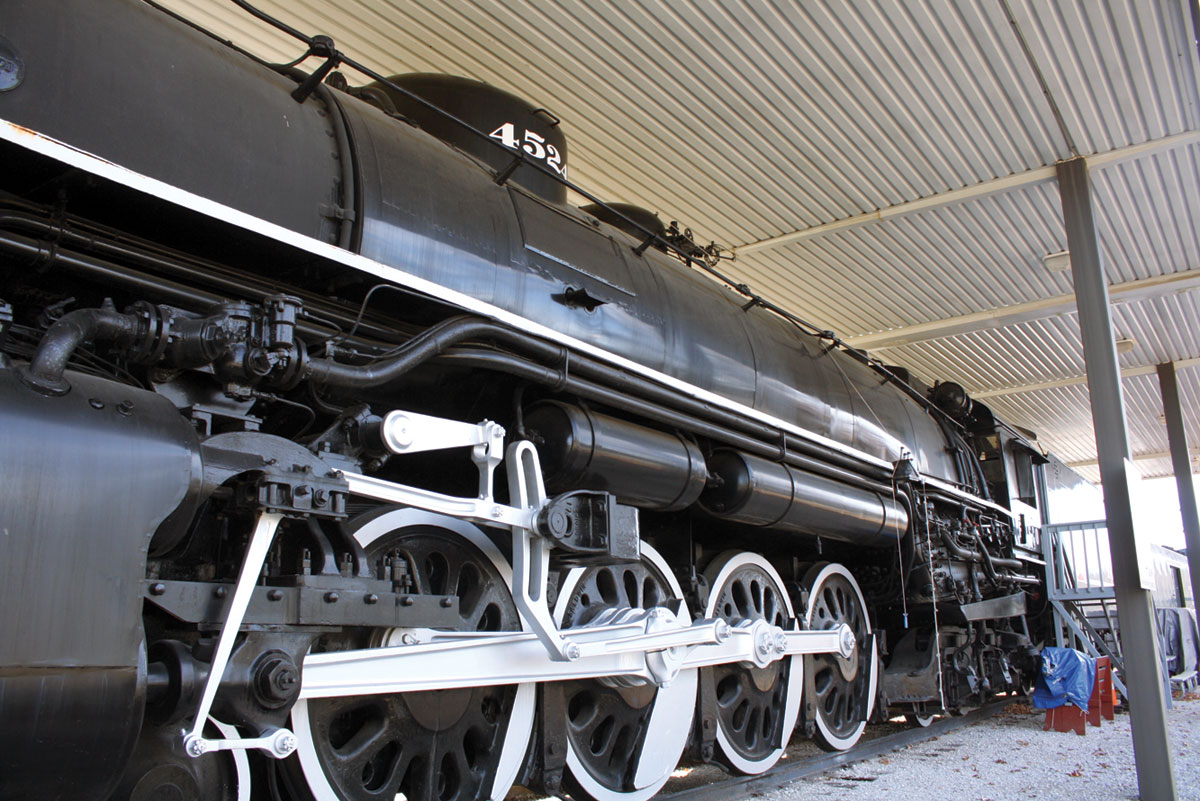
One of the last steam locomotives in operation shares the history of the railroad in the Ozarks
In the fall of 1953, the mighty Frisco 4524 made its last trip, but the historic locomotive’s bell still rings out, welcoming passengers of all ages.
At one time, Southwest Missouri was a hub of railroad transportation. Springfield, Mo., was in the middle of the Frisco line from Kansas City to Florida and St. Louis to Texas. The railroad provided many jobs, and trains connected small towns across rural Missouri. The Frisco 4524 was one of the engines to make rounds across the Ozarks.
Built in Pennsylvania in 1942, the Frisco 4524 was one of the last of 25 steam locomotives constructed for the Frisco Railroad. They were among the biggest, most powerful (5,600 horsepower) steam locomotives on the rails.
A decade later, however, the steam-powered locomotives were gone, replaced by diesel engines.
Railroad historians say the city of Springfield wanted to honor its railroad roots with a locomotive for one of its parks, and Frisco donated the 4524. The engine, however, was blocks from its final destination at Grant Beach Park, and there were no tracks to follow. A temporary switch was installed to take the 4524 off the line, and using air pressure instead of steam, workers slowly but surely moved the locomotive along temporary tracks, which were leap frogged in 40-foot sections and moved by a large crane down the middle of the street. After several, the 462,000-pound Frisco 4524 was at its final stop. Natives of the Springfield, Mo., area occasionally stop by the old locomotive and recall watching in awe as the train was moved; others can recall their father or grandfather being involved in the actual moving operation.
The Springfield locomotive is one of only four of the 25 locomotives made that remain, with the others being located in Frisco, Texas; Tulsa, Okla.; and Sedalia, Mo.
Unfortunately, the massive locomotive sat with little attention for many, many years. John Wollard, president of the 11-member Railroad Historical Museum, Inc., board, said there seemed to be some argument about who was exactly responsible for the upkeep of the locomotive, be it the Springfield-Greene County Park Board or the Frisco Railroad.
Thanks to a little prodding from his father, Eddie Felin, who worked for the railroad in the coach works division, patched up the old locomotive.
“His dad was retired and watched this engine rust away for 20 years,” John said. “After all of the finger pointing, Eddie brought down some body putty and fixed it up,” John, a second-generation railroad man who retired in 2008 after a 45-year career with Frisco and Burlington Northern Santa Fe railways, said.
The Railroad Historical Museum, Inc., officially formed in 1987 and now oversees the Frisco 4524, which is still owned by the city of Springfield and is the focal point of an outdoor museum at Grant Beach park. The Springfield-Greene County Park Board and the Railroad Historical Museum, Inc., work together at the museum grounds, with the majority of the work falling to the members of the Railroad Museum, who are all volunteers.
John explained that the board was formed and began working to make improvements to the park and preserving the history of the railroad in the Ozarks.
Today the Frisco 4525 is attached to a Burlington baggage car, Chicago and Northwestern commuter car and Burlington Northern caboose, which are filled with memorabilia, uniforms, photos, artifacts and news clippings from the golden age of rail travel. John said there are other items in storage that still need to be moved to the museum, but finding the room can be challenging.
Many of the items are unique and can only be found there, including a cast iron stove that was rescued from the last wooden caboose owned by Fricso before the company burnt all of the cars.
Perhaps the oldest item in the museum is a replica of the American Type 4-4-0 Frisco locomotive and tender box built at the North Shops in Springfield, Mo., in 1903. The glass and wood encased train was first displayed at the St. Louis Worlds Fair in 1904.
The board recently completed the construction of a replica train station next to the train, the Max Jahn Depot, named after a longtime member of the Railroad Historical Museum, thanks to support of various donors, including the Musgrave Foundation.
“It was patterned after an 1898 basic, three-room depot,” John said. “There’s a freight room, office and a waiting area.”
Inside the office portion of the depot, John said, is as authentic as possible, right down to the Prince Albert tobacco can used on the telegraph to amplify the sound of the incoming messages.
“We’ve even got the old types of telephones they used,” John said. “Some of the items here are gone forever, but they’re here. We’ve had kids who’ve come through and never seen a typewriter.”
Many of the items housed in the train and inside the depot have been given or loaned to the museum from private collections. Some of the items have also come from other museums. Videos play in the depot and train, showing how the 4524 came to the Grant Beach Park, and visitors are welcome to pull up a chair and watch them in their entirety.
What makes the museum different than many others is that guests are welcome to touch many of the items on the old locomotive, actually sit in the engineer’s seat, climb the steps to the second deck of the commuter car and ring the bell of the iconic Frisco 4524, which was repaired and repainted a few years ago by volunteers.
“Inside the engine, if it will turn, you can turn it; if it moves, move it,” John said. “You aren’t going to hurt anything.”
While the museum is meant for all ages, John said younger children might not appreciate the massive steam engine.
“The little kids come over and they expect to see Thomas the Tank Engine,” John said with a laugh. “They are sometimes a little disappointed when the go around to the front and it’s not Thomas, but they have fun.”
John started working for the railroad about 10 years after steam locomotives were phased out, but he, like many of the other volunteers, has immersed himself in the history of the locomotive, the cars, the memorabilia and the nostalgia of the rail system in the Ozarks. Despite retiring a decade ago, John easily recalls where each line began and ended, and can still easily climb up to the observation chairs in the caboose, and show the easiest way to negotiate back down the narrow steps.
“After I retired, I was just looking for something to do,” he said. “Most of the guys here are old railroaders, too. My dad worked on the old steam engines, so did my uncle. I really didn’t pay any attention to their stories because it was just a job to me. I wish now that I had listened a little more.”
There is no charge to tour the museum, which is open from noon to 2 p.m. each Saturday in the months of May through October, as well as by appointment. The museum can also be booked for private parties with a donation of $40. In the summer months, the cars are air conditioned, but the winter months may be a little cool as there is no heat.
“We’ll open up whenever someone wants to see it,” John said just before offering to give a tour to a father and his daughter who were playing in the park on a recent warm January day quickly proves his dedication to sharing the story and history of the railroad in Southwest Missouri. “If someone wants to see it, any day of the week, we’ll come over and open it up. One person or a family, we’ll open up.”







